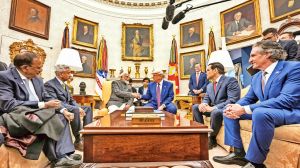Know Your City: Race Course – The Heart of Rajkot
From being the epicentre of every major festival in the biggest city of Saurashtra to having the most important government offices and residences surrounding it; from fun fair rides for kids to sports for the youth and walking tracks and gardens for the elderly, the Race Course along with its Ring Road has everything except the eponymous horse racing
 The Race Course also houses a professional hockey ground, football ground, indoor stadium, swimming pool and gym, an art gallery, the Bal Bhavan, an open-air theatre and gardens. (Express Photo)
The Race Course also houses a professional hockey ground, football ground, indoor stadium, swimming pool and gym, an art gallery, the Bal Bhavan, an open-air theatre and gardens. (Express Photo)From a former Governor walking its athletic track to football players from various parts of India hoping to win a statewide tournament just 200 metres away, people on evening walks briskly stepping onto its outer ring to the chaos of commuters heading back home along the main road and children riding horse-drawn carriages on their winter break, the Race Course in Rajkot paints the perfect picture of an idyllic city centre.
The Race Course, an approximately 2.5 km loop in the centre of Rajkot, was constructed during the British Raj by Sir Lakhajirajsinhji II, the 12th Thakore Saheb of the Rajkot Princely State, as a venue for horse racing, for which he had picked up a fondness during his visits to England. Locals say that the police lines, which lay right next to the current residence of the Commissioner of Police, used to be the horses’ stables.
Today, the Race Course has the main road – the Ring Road – running on its outer circumference while there is a part of a road that runs through the interior part where development has taken place, while the other half remains a dirt ground where, every Sunday, more than a hundred people play cricket with makeshift pitches whose players crisscross through each other’s fields and hilarity ensues when a player from one game catches the ball played by a batsman from another team. But the Race Course also holds the very first international cricket venue in Saurashtra, the Madhavrao Scindia cricket ground, which has seen Vivian Richards score 110 not out off 77 balls to defeat India in January 1988, and Yuvraj Singh score 138 not out off 78 balls to defeat England, 20 years later in 2008.
 Sportspersons running at the athletic track. (Express Photo)
Sportspersons running at the athletic track. (Express Photo)
The Race Course also houses a professional hockey ground, football ground, indoor stadium, swimming pool and gym, an art gallery, the Bal Bhavan, an open-air theatre and gardens.
On Sunday, two football teams from Ahmedabad battled in the final match of the 13th Open Gujarat Football Tournament where ARA Club bested the team of the RBI Ahmedabad 1:0. This is the only statewide invitation tournament played in Gujarat and the only one open to all, that is hosted by any city police.
Speaking on the Race Course, Brajesh Kumar Jha, Commissioner of Police, Rajkot, says, “The Race Course is the heart of the city. Apart from my residence, my office and the Police Headquarters being located here, all the sports facilities are fantastic and centred in one place which is not found in any other city of Gujarat. There are two gardens, one only for women, an exhibition centre and for children also facilities are there and lots of eateries are there. If you do not want to go anywhere else, you can just come to the Race Course and you will find everything in one place.”
On the other side of the Race Course, towards the main gate, and the road that leads to the old airport, right under the statue of former prime minister Rajiv Gandhi, stands an example of Gujarati enterprise – 25-year-old Ajay Chanchalani – the ‘hot dog man’. Standing at the same place, his former employer Pasabhai sold hot dogs for the previous four decades. Ajay Chanchalani and his brother have taken over the business from the former boss, continuing to sell hot dogs, an absolute favourite for locals and especially children, in spite of the fact that the development of this city has brought major fast food giants just 200-300 metres away from this 40-year-old shop on cycle on the prestigious Ring Road.
 A street vendor making Kahwa. (Express Photo)
A street vendor making Kahwa. (Express Photo)
On the Race Course, Ajay Chanchalani says, “The people in Rajkot cannot do without the Race Course. There is something here for the young and old. From Diwali to Janmashtami to New Year and Dhuleti, there is nowhere more enthusiasm than at the Race Course. It cannot be replaced.”
Ajay Chanchalani was referring to the new public venues that have rapidly expanded over the last decade, especially considering that Rajkot was the constituency of former chief minister Vijay Rupani. These new attractions include the Atal Sarovar (dubbed the new race course), Ishwariya Park, Science City, Aji Dam, Nyari Dam and the Pradyuman Zoological Park.
The Indian Express also spoke to Sheetal Vadodaria, a school teacher who had accompanied her sister and her three children, visitors from Sydney, Australia, to the amusement rides parked right next to the main gate of the Race Course. This is one of two locations in the Race Course where ride owners set up their rides apart from a privately owned Amusement Park called Fun World.
On being asked why she had brought her nephew and nieces here, Vadodaria says, “The children have gone on a ride on the horse-drawn carriage which can only be found here. Whenever they visit India, it is an absolute must for them to come for rides here at the Race Course regardless of wherever else they go. The last time they came was on Janmashtami and we had to attend the fair without fail. There are many places to visit now in Rajkot but the Race Course remains their favourite.”
The area around the Ring Road is also considered a prime location with major central and state government offices located there including the Income Tax, GST, Indian Oil Corporation and the office of the Comptroller and Auditor General (CAG). It also has Rajkot’s first major apartment building, the iconic Galaxy Cinema (now under redevelopment), the Mayor’s bungalow, residences of the Commissioner of Police and other IPS and IAS officers, and the Bahumadi Bhavan (state government offices), which also houses a replica of the Sardar Sarovar Dam complete with the statue of Sardar Vallabhbhai Patel.
 Children in horse drawn carriage. (Express Photo)
Children in horse drawn carriage. (Express Photo)
Standing just outside the CAG office is Haresh Rijwani, of Jalaram Kahwa, a third-generation business owner who boasts an impressive and loyal clientele of health-conscious Rajkotians crowding to sip his hot concoction, especially in the winter. Proudly showing a photo with India cricketer Jaydev Unadkat, Rijwani says, “So much has changed since I started working with my father here in 1986. The roads have become broader, now there are gardens and it is more convenient for people. There is more traffic and even though the city is bigger, more and more people come to visit the Race Course. Rajkot may change but the Race Course never will.”
The athletics field, earlier a 400-metre dirt track, is now a professional zone where everyone from state sportsmen to budding players goes to train. Jenish Ravrani, 21, a police recruitment candidate from Junagadh, says he had been running at the track for less than a week after recently discovering it. He adds that it rivals the track at Saurashtra University. Ravrani hopes to make his performance worthy of wearing the Khaki in the near future.
Just outside the athletic track, the Indian Express ran into Vajubhai Vala, not just the former Governor of Karnataka, but a former mayor of Rajkot city. Speaking on the Race Course, Vala says, “The walking track is the best one in Gujarat and thousands of people use it. Day after day, people are getting more health conscious and walking and running is very important. The entire complex is so neat and clean that I’ve had no cause to complain. In fact, the Race Course is the one place where you can breathe clean air.”
“When there was no turf wicket, I had the first one made right here in the Race Course when I was the mayor. And all international teams have played here. The Saurashtra public welcomed everyone here. I believe that such complexes should be built in every district and the youths should make this demand from their administration,” Vala adds.
On the importance of the Race Course itself, Vala, who has also served as finance minister of Gujarat and Speaker of its Assembly, further says, “There is a new race course but this place is well established and loved by the people. As they say, old is gold.”












